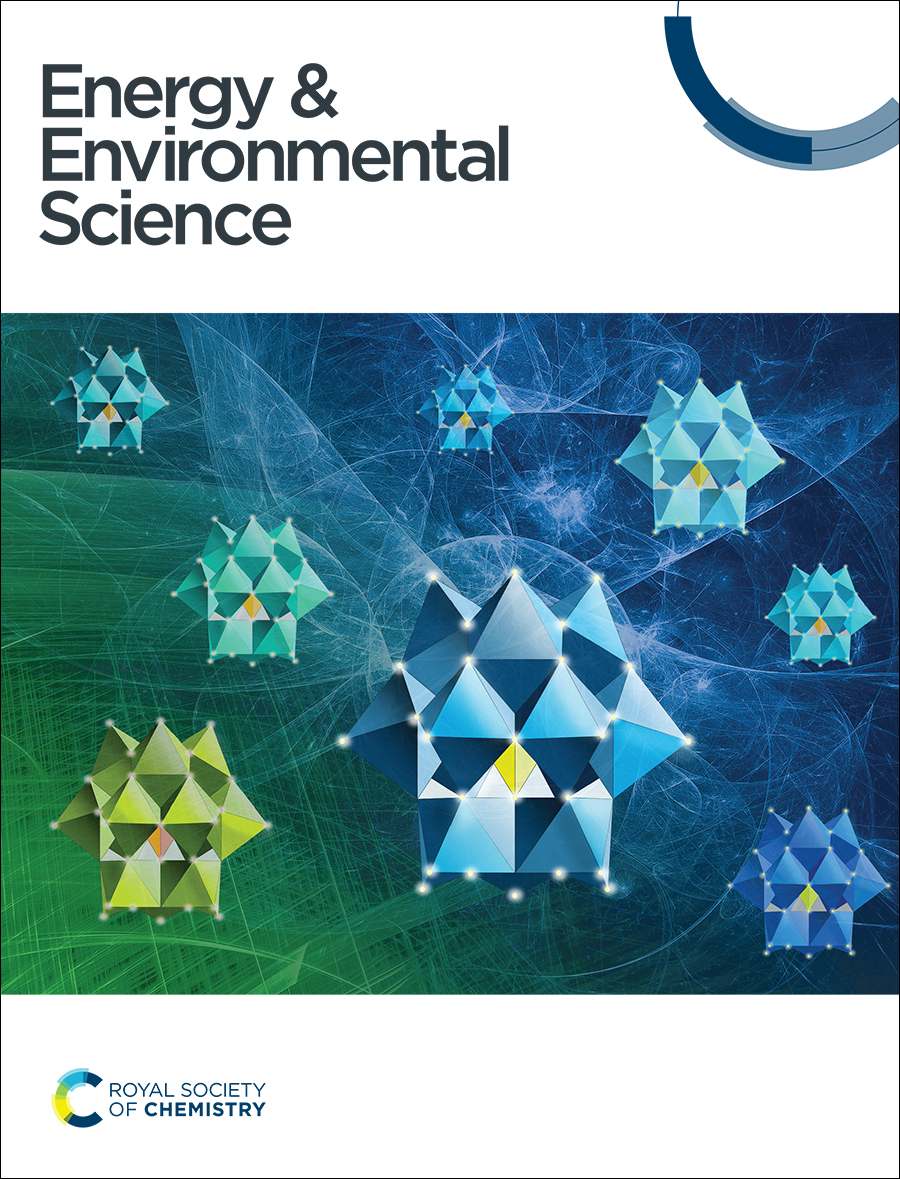You can find details about how to access information remotely in this step-by-step guide. The guide will also help if for any reason you have difficulty accessing the content you want.
What would you like to know about this journal?
Impact factor: 32.4*
Time to first decision (all decisions): 10.0 days**
Time to first decision (peer reviewed only): 41.0 days***
Chair: Jenny Nelson
Open access publishing options available
Journal scope
Energy & Environmental Science is an international journal dedicated to publishing exceptionally important and high quality, agenda-setting research tackling the key global and societal challenges of ensuring the provision of energy and protecting our environment for the future.
The scope is intentionally broad and the journal recognises the complexity of issues and challenges relating to energy conversion and storage, alternative fuel technologies and environmental science.
For work to be published it must be linked to the energy-environment nexus and be of significant general interest to our community-spanning readership. All scales of studies and analysis, from impactful fundamental advances, to interdisciplinary research across the (bio)chemical, (bio/geo)physical sciences and chemical engineering disciplines are welcomed.
Topics include, but are not limited to, the following:
- Solar energy conversion and photovoltaics
- Solar fuels and artificial photosynthesis
- Fuel cells
- Hydrogen storage and (bio) hydrogen production
- Materials for energy systems
- Capture, storage and fate of CO2, including chemicals and fuels from CO2
- Catalysis for a variety of feedstocks (for example, oil, gas, coal, biomass and synthesis gas)
- Biofuels and biorefineries
- Materials in extreme environments
- Environmental impacts of energy technologies
- Global atmospheric chemistry and climate change as related to energy systems
- Water-energy nexus
- Energy systems and networks
- Globally applicable principles of energy policy and techno-economics
Meet the EES family
Hear from the EES Editorial Board
Discover the unique vision and impact of Energy & Environmental Science (EES) through the voices of our esteemed Editorial Board Members. Editorial Board Chair Professor Jenny Nelson is joined by Professor Jan Rossmeisl, Professor Karen Wilson and Professor Xiaojing Hao to share the journal’s scope, its importance in advancing the field, and why EES is the ideal platform for your research. We invite you to watch the video below and consider joining our influential community of authors.
Meet the team
Find out who is on the editorial and advisory boards for the Energy & Environmental Science journal.
Chair
Jenny Nelson, Imperial College London, UK
Editorial board members
Xinhe Bao, Fudan University, China
Christoph Brabec, University of Erlangen-Nuremberg, Germany
William Chueh, Stanford University, USA
Kazunari Domen, The University of Tokyo, Japan
Xiaojing Hao, University of New South Wales, Australia
Linda Nazar, University of Waterloo, Canada
Jan Rossmeisl, University of Copenhagen, Denmark
Jennifer Wilcox, University of Pennsylvania, USA
Karen Wilson, Griffith University, Australia
Markus Antonietti, Max Planck Institute of Colloids and Interfaces, Germany
Bernie Bulkin, Sustainable Development Commission, UK
Stephen Campbell, Automotive Fuel Cell Cooperation, Canada
Emily Carter, Princeton University, USA
Kylie Catchpole, Australian National University, Australia
Wonyong Choi, Korea Institute of Energy Technology, Korea
Ib Chorkendorff, Technical University of Denmark, Denmark
Peter Dobson, University of Oxford, UK
Nieves Espinosa, University of Murcia, Spain
Hongjin Fan, Nanyang Technological University, Singapore
Elzbieta Frackowiak, Poznan University of Technology, Poland
Hermenegildo García, Instituto de Tecnología Química CSIC-UPV, Spain
José Goldemberg, University of São Paulo, Brazil
Harry Gray, California Institute of Technology (Caltech), USA
Dirk Guldi, University Erlangen-Nürnberg, Germany
Anders Hagfeldt, École polytechnique fédérale de Lausanne EPFL, Switzerland
Laura Herz, University of Oxford, UK
Steven Holdcroft, Simon Fraser University/NRC, Canada
George Huber, University of Wisconsin-Madison, USA
Oliver Inderwildi, University of Oxford, UK
Saiful Islam, University of Oxford, UK
Mercouri G Kanatzidis, Northwestern University, USA
Thomas Kirchartz, Forschungszentrum Jülich (FZJ), Germany
Akihiko Kudo, Tokyo University of Science, Japan
Pooi See Lee, Nanyang Technological University, Singapore
Nathan Lewis, California Institute of Technology (Caltech), USA
Chengdu Liang, Center for Nano-phase Materials Sciences Oak Ridge National Laboratory, USA
Jeffrey R Long, University of California Berkeley, USA
Yi-Chun Lu, Chinese University of Hong Kong, China
Christopher R McNeill, Monash University, Australia
Shelley Minteer, Missouri University of Science and Technology, USA
Arthur Nozik, National Renewable Energy Laboratory, USA
Satish Ogale, Indian Institute of Science Education and Research IISER, Pune, India
Annamaria Petrozza, Istituto Italiano di Tecnologia, Italy
Zhiyong Jason Ren, Princeton University, USA
Rodney Ruoff, Ulsan National Institute of Science & Technology, Korea
Jennifer Rupp, Massachusetts Institute of Technology, USA
Srinivasan Sampath, Indian Institute of Science, India
Uwe Schröder, TU-Braunschweig, Germany
David Sinton, University of Toronto, Canada
Henry Snaith, University of Oxford, UK
Robert Socolow, Princeton University, USA
Jefferson W Tester, Cornell University, USA
Dan Wang, Institute of Process Engineering, Chinese Academy of Sciences, China
Peng Wang, Zhejiang University, China
Michael R Wasielewski, Northwestern University, USA
Li-Zhu Wu, Technical Institute of Physics and Chemistry, Chinese Academy of Sciences, China
Bilge Yildiz, Massachusetts Institute of Technology, USA
Kyung Byung Yoon, Sogang University, Korea
Yan Yu, University of Science and Technology of China, China
Jincai Zhao, Center for Molecular Science, China
Tim S Zhao, The Hong Kong University of Science & Technology, Hong Kong
Emma Eley, Executive Editor ORCID 0000-0002-6379-8502
Bianca Provost, Deputy Editor ORCID: 0000-0001-8440-1095
Nour Tanbouza, Development Editor ORCID 0000-0002-9729-0918
Callum Woof, Development Editor ORCID 0000-0003-0601-3438
Claire Darby, Editorial Manager ORCID 0000-0003-3059-6020
Katie Fernandez, Associate Editorial Manager
Robin Brabham, Publishing Editor ORCID 0000-0002-8055-4016
Emma Carlisle, Publishing Editor
Hannah Hamilton, Publishing Editor
Ephraim Otumudia, Publishing Editor ORCID 0000-0002-9551-3591
Rebecca Milne, Publishng Editor
Irene Molina Santos, Publishing Editor ORCID 0000-0002-4766-9436
Michael Spencelayh, Publishing Editor
Kate Bandoo, Editorial Assistant
Linda Warncke, Publishing Assistant
Sam Keltie, Publisher, Journals, ORCID 0000-0002-9369-8414
Peer review and editorial process
All submissions to Energy & Environmental Science are expertly evaluated by our dedicated editorial team.
The peer review for all articles submitted to the journal consists of the following stages:
- Your manuscript is initially assessed by an editor to determine its suitability for peer review. This includes an evaluation by the editor of the manuscript’s scope, quality, significance, novelty and broad appeal. Your manuscript may be rejected at this stage if it does not meet the essential criteria for the journal.
- If the manuscript passes the initial assessment process, we will solicit recommendations from at least two anonymous reviewers who are experts in the field. They will provide a report along with their recommendation.
- The editor handling your manuscript makes a decision based on the reviewer reports received balanced with the editorial criteria for the journal. In the event that no clear decision can be made, additional reviewer(s) may be consulted.
Around 90% of submissions received to Energy & Environmental Science are rejected. If your manuscript is rejected from Energy & Environmental Science, the editorial team will endeavour to find an alternative journal at the RSC to publish your paper and we will communicate this to you. If your manuscript has been peer-reviewed at Energy & Environmental Science then those reviewer reports may be used to enable the editor at the receiving journal make a swift decision to accept your manuscript based on your full response to those reports. If you wish to transfer your manuscript to a journal other than the one which was recommended by the editor, please contact the editorial office. You can browse all RSC journals here.
Energy & Environmental Science is committed to a rigorous peer review process and expert editorial oversight for all published content. Please refer to our processes and policies for full details.
Appeal procedure
Energy & Environmental Science is a journal with very demanding acceptance criteria. Manuscripts must demonstrate significant broad appeal and meet a series of important editorial criteria around scope, novelty, rigour, innovation and significance. As such, around 90% of manuscripts submitted to the journal are rejected. Authors have the right to appeal to the editor against any decision taken on their manuscript, and all appeal applications will be considered carefully by the editorial team. Examples of where an appeal may be justified might include cases where authors can demonstrate that the reviewer(s) have misinterpreted an aspect of the work, or a reviewer’s recommendation is based on a factual error. A comprehensive rebuttal letter needs to be supplied by the author if this is the case. Differences in opinion regarding novelty, general significance and or impact of the work are not considered grounds for an appeal. Appeals are granted at the discretion of the editor. All appeal requests are handled on a case-by-case basis, and the editor's decision is final. Appeals will only be considered on manuscripts that have not been revised. If you submit a revised version of a previously considered manuscript this will be treated as a resubmission and not an appeal.
Resubmissions
If a manuscript which has been previously considered by the journal is revised and resubmitted via the ScholarOne portal, the case will be considered carefully by the journal editorial office. The editorial team will not engage with an informal submission outside of the ScholarOne portal (e.g. by email). A member of the journal editorial or advisory board may be consulted on the suitability of the revised manuscript for further review. If the editor finds that the manuscript does not meet the editorial demands of the journal and/or has not been revised to their satisfaction, a decision to reject without further peer review or offer an alternative RSC journal may be given.
Transparent peer review
As part of our commitment to transparency and open science, Energy & Environmental Science offers authors the option of transparent peer review, where the editor’s decision letter, reviewers’ comments and authors’ response for all versions of the manuscript will be published alongside the article under an Open Access Creative Commons licence (CC-BY).
Reviewers will remain anonymous unless they choose to sign their report.
Find out more about our transparent peer review policy and read our Editorial on transparent peer review in Energy & Environmental Science.
Open access publishing options
Energy & Environmental Science is a hybrid journal and gives authors the choice of publishing their research either via the traditional subscription-based model or instead by choosing our gold open access option.
Gold open access
For authors who want to publish their article gold open access, Energy & Environmental Science charges an article processing charge (APC) of £3,000 (+ any applicable tax). Our APC is all-inclusive and makes your article freely available online immediately, permanently, and includes your choice of Creative Commons licence (CC BY or CC BY-NC) at no extra cost. It is not a submission charge, so you only pay if your article is accepted for publication.
Learn more about publishing open access.
Open access agreements
If your institution has an RSC open access agreement or APCs for gold open access, publishing in this journal may already be covered.
Use our journal finder to check if your institution has an open access agreement with us.
Please use your official institutional email address to submit your manuscript and check you are assigned as the corresponding author; this helps us to identify if you are eligible under an open access agreement or other APC discounts.
Traditional subscription model
Authors can also publish in Energy & Environmental Science via the traditional subscription model without needing to pay an APC. Articles published via this route are available to institutions and individuals who subscribe to the journal. Our standard licence allows you to make the accepted manuscript of your article freely available after a 12-month embargo period. This is known as the green route to open access.
Energy & Environmental Science Lectureship
This Lectureship recognises an outstanding emerging investigator working on an energy research topic within the scope of Energy & Environmental Science, providing a platform to showcase their research to the wider scientific community.
Find out more about eligibility, how to nominate, nomination deadlines and see all the winners of this lectureship.
Readership information
The journal appeals to chemical scientists, chemical and process engineers, energy researchers, bio-scientists and environmental scientists from across academia, industry and government.
Subscription information
Energy & Environmental Science is part of RSC Gold and Materials Science subscription packages.
Online only 2025: ISSN 1754-5706, £1,733 / $3,136
Themed Issues
Energy & Environmental Science does not currently accept proposals for themed/special issues in the journal.
We encourage you to submit any proposals for themed/special issues to one of our related journals, such as the ones listed here.
*2023 Journal Citation Reports (Clarivate Analytics, 2024)
**The median time from submission to first decision including manuscripts rejected without peer review from the previous calendar year
***The median time from submission to first decision for peer-reviewed manuscripts from the previous calendar year
Energy & Environmental Science
- Email:
- click here
- Email:
- Send us an email
Share
Advertisement






